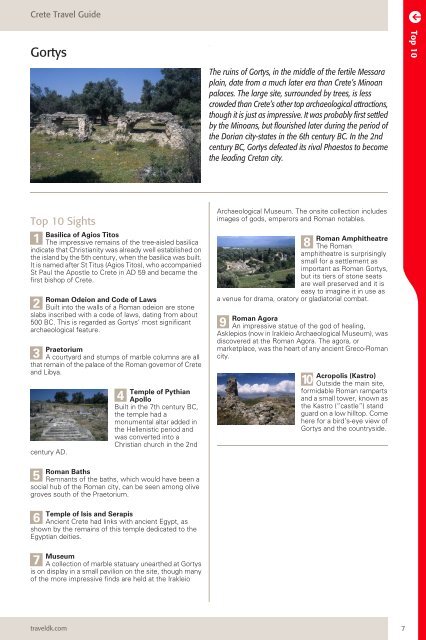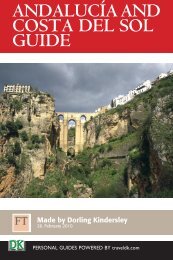CRETE TRAVEL GUIDE
CRETE TRAVEL GUIDE
CRETE TRAVEL GUIDE
You also want an ePaper? Increase the reach of your titles
YUMPU automatically turns print PDFs into web optimized ePapers that Google loves.
Crete Travel Guide<br />
Gortys<br />
Top 10 Sights<br />
1<br />
Basilica of Agios Titos<br />
The impressive remains of the tree-aisled basilica<br />
indicate that Christianity was already well established on<br />
the island by the 5th century, when the basilica was built.<br />
It is named after St Titus (Agios Titos), who accompanied<br />
St Paul the Apostle to Crete in AD 59 and became the<br />
first bishop of Crete.<br />
2<br />
Roman Odeion and Code of Laws<br />
Built into the walls of a Roman odeion are stone<br />
slabs inscribed with a code of laws, dating from about<br />
500 BC. This is regarded as Gortys’ most significant<br />
archaeological feature.<br />
3 Praetorium<br />
A courtyard and stumps of marble columns are all<br />
that remain of the palace of the Roman governor of Crete<br />
and Libya.<br />
century AD.<br />
5<br />
4<br />
Temple of Pythian<br />
Apollo<br />
Built in the 7th century BC,<br />
the temple had a<br />
monumental altar added in<br />
the Hellenistic period and<br />
was converted into a<br />
Christian church in the 2nd<br />
Roman Baths<br />
Remnants of the baths, which would have been a<br />
social hub of the Roman city, can be seen among olive<br />
groves south of the Praetorium.<br />
6<br />
Temple of Isis and Serapis<br />
Ancient Crete had links with ancient Egypt, as<br />
shown by the remains of this temple dedicated to the<br />
Egyptian deities.<br />
7 Museum<br />
A collection of marble statuary unearthed at Gortys<br />
is on display in a small pavilion on the site, though many<br />
of the more impressive finds are held at the Irakleio<br />
traveldk.com<br />
The ruins of Gortys, in the middle of the fertile Messara<br />
plain, date from a much later era than Crete’s Minoan<br />
palaces. The large site, surrounded by trees, is less<br />
crowded than Crete’s other top archaeological attractions,<br />
though it is just as impressive. It was probably first settled<br />
by the Minoans, but flourished later during the period of<br />
the Dorian city-states in the 6th century BC. In the 2nd<br />
century BC, Gortys defeated its rival Phaestos to become<br />
the leading Cretan city.<br />
Archaeological Museum. The onsite collection includes<br />
images of gods, emperors and Roman notables.<br />
Roman Amphitheatre<br />
The Roman<br />
amphitheatre is surprisingly<br />
small for a settlement as<br />
important as Roman Gortys,<br />
but its tiers of stone seats<br />
are well preserved and it is<br />
easy to imagine it in use as<br />
a venue for drama, oratory or gladiatorial combat.<br />
9<br />
Roman Agora<br />
An impressive statue of the god of healing,<br />
Asklepios (now in Irakleio Archaeological Museum), was<br />
discovered at the Roman Agora. The agora, or<br />
marketplace, was the heart of any ancient Greco-Roman<br />
city.<br />
8<br />
10<br />
Acropolis (Kastro)<br />
Outside the main site,<br />
formidable Roman ramparts<br />
and a small tower, known as<br />
the Kastro (“castle”) stand<br />
guard on a low hilltop. Come<br />
here for a bird’s-eye view of<br />
Gortys and the countryside.<br />
7<br />
Top 10
















